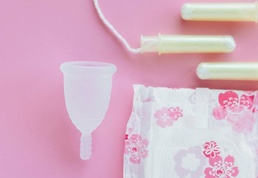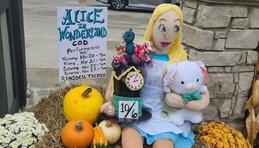Mehndi Madness
July 18, 2007
In the U.S., it’s typically called “henna tattooing” (although this term is quite incorrect–we’ll ex-plain in a minute) and it can be found everywhere from upscale galleries and cultural events to amusement parks, county fairs, and sidewalk vendors. But exactly what is it?Well, the simplest ex-planation for Westerners is that it’s a trendy and beautiful form of body art that is most popular in the summer months, especially in resort areas like Northern Michigan. But henna’s history reaches much farther than a mere seasonal fad.
Henna is actually a flowering plant that grows primarily in South Asia and North Africa. The plant has been used for a wide range of applications, including as a preservative and dye for cloth and leather, as a medical paste that is said to wick fever out of the body, as a medicinal herb, and as both an insect and mildew repellant.
When its leaves are dried and ground into a fine powder, then mixed into a paste with various oils, teas, and lemon juice, henna also has a high natural staining factor on human skin and hair. It has been used as a hair dye and body art medium since as far back as the late Bronze Age (around 1,400 BC.)
THE ART OF MEHNDI
The paste itself is also called henna - but the art of the paste’s application is called Mehndi. The paste is applied using a variety of methods depending on the culture.
Here’s where we discover the reason that “henna tattooing” is an incorrect term.
A tattoo is a permanent insertion of pigments underneath the skin, while Mehndi uses organic staining pigments that rest on the outermost layers of the skin creating a temporary design that gradually wears away. Seeing “henna tattooing” on a sign can, unfortunately, frighten people away from trying this fascinating and fun cultural art, as they assume that needles are used when nothing could be farther from the truth. However, even reputable Mehndi artists are now reluctantly using this terminology because it has become the most recognizable term for Mehndi in the Western world.
Henna is applied to the skin in several ways, none of which involve needles or puncturing. The paste may be painted onto the skin with a paintbrush, porcupine quill, plastic cone, or metal-tipped plastic bottle.
Quick-draw henna artists - the kind more concerned with the money than the art form - will often use stencils (meaning cookie-cutter designs that look pretty much the same on anyone). But if you want a truer-to-form Mehndi experience, find a henna artist who draws everything freehand. Most offer books of design ideas; if you prefer, you can suggest a theme to the artist (flowers, tribal designs, geometrics, etc.) and you’ll get a design that’s unique to you.
LOCATION, LOCATION
Mehndi is usually drawn on the hands (tops or palms) and tops of the feet, where the color will be darkest, as the skin is stronger in these places and contains higher levels of keratin.
It is also often applied to the upper arm or
upper back, especially in the West, and is sometimes attempted on the face, although the color in these places won’t be as dark.
The paste design is left to dry for at least an hour or two. The longer the paste is left on, the darker and more long-lasting the design will be. The dried paste is later gently scraped off at home to reveal a reddish-brown design (henna’s natural color) that can last anywhere from a week to a month depending on the quality of the henna and the care of the skin.
In India, henna is most often applied for weddings and festivals, while in Persian and Arabic-speaking countries, it’s done for many special occasions and events.
Mehndi was adapted to Western culture beginning in the late 1990s, when everyone from Gwen Stefani and Madonna to Sting and Prince were seen adorned with henna patterns. It is, of course, frequently seen in Bollywood films (“Bride and Prejudice,” “Lagaan”), and it’s now a popular form of summer adornment for the hands, feet or ankles, replacing metal jewelry in the hotter seasons.
BLACK HENNA
With all of this henna activity, one would assume Mehndi is safe. And, for the most part, you’d be exactly right. Since henna is usually mixed with all-organic ingredients, allergic reactions are rare–if anything, a person may be allergic to another of the ingredients used in the henna paste mix, which range from oils such as eucalyptus or geranium to the aforementioned lemon or lime juice.
The one exception to safe henna is something mistakenly called “black henna,” which is often requested due to its extremely dark, jet-black color. Black henna - which usually doesn’t even have any actual henna in it - is currently in widespread use in many tourist areas, especially in Mexico. Although you might appreciate the darkness of your design at first, you’re taking a huge risk with what might happen a few days later, which is why a genuine henna artist who’s studied the history of real henna art will refuse to use it.
In an effort to capitalize on the Mehndi’s popularity, many fly-by-night body art vendors began experimenting with new ingredients in order to compete in the henna art market and get darker designs. Most of these new ingredients are primarily comprised of either pen inks or PPDs (para-phenylenediamine), which are most often used in hair dyes. Neither of these sub-stances are safe in high concentrations for skin.
PPDs in hair dye are generally strongly regulated in Western countries; only very small percentages are allowed in over-the-counter or salon hair formulations. In black henna pastes, however, the PPD percentages can range anywhere from 10 to 60 percent. The result?
Well, usually nothing for the first couple of days, which is why many eager tourists scoff
at the warnings against black henna–
but shortly thereafter, up to 20 percent of people who receive these falsely-labeled henna tattoos will experience side
effects as mild as itching and as extreme as blistering and perm-anent scarring. Even
if it’s well-drawn, do you really want that flower or tribal design permanently embedded into your arm?
THE REAL DEAL
So how do you tell if you’re actually getting organic henna - or a concoction of other dyes? Simply ask and observe. Real henna artists will be able to tell you what is in their henna mix, and suggest you leave your henna paste on for a minimum of one hour. The paste itself will be a dark brown or olive green color, not black. The resulting design stain after the paste is removed will range from orange to a dark reddish-brown, and will darken over 24 hours, but you will rarely get anything even near a black color. What you will get will be an exotic, one-of-a-kind design that will last through your vacation, and the memory of your fun and unique Mehndi experience will likely last even longer than that.
Writer Kristi Kates is a Mehndi artist. Mehndi/henna art is available in Charlevoix at C2 Gallery (327 Bridge Street downtown, most summer weekends), through Bijani Mehndi at Blissfest and Petoskey Sidewalk Sales, and at various beauty salons throughout Northern Michigan. For more info, check out www.myspace.com/bijanimehndi and http://en.wikipedia.org/wiki/Mehndi
Trending

Seasonal Showtime: 20+ Holiday Shows, Concerts, Ballets, and Plays
Come the holidays, the Prince of the Land of Sweets will again reign supreme. If it’s Christmas time, it’s time … Read More >>
Affordable Menstrual Products Up North
Northwestern Michigan College health science student Zinnia Burks wants to understand the prevalence of “period povert… Read More >>
Off to Wonderland in Manistee
Fresh off the spooky fun of It Was a Dark and Stormy Night, and acting as the bridge between that show from the Manistee Civ… Read More >>


